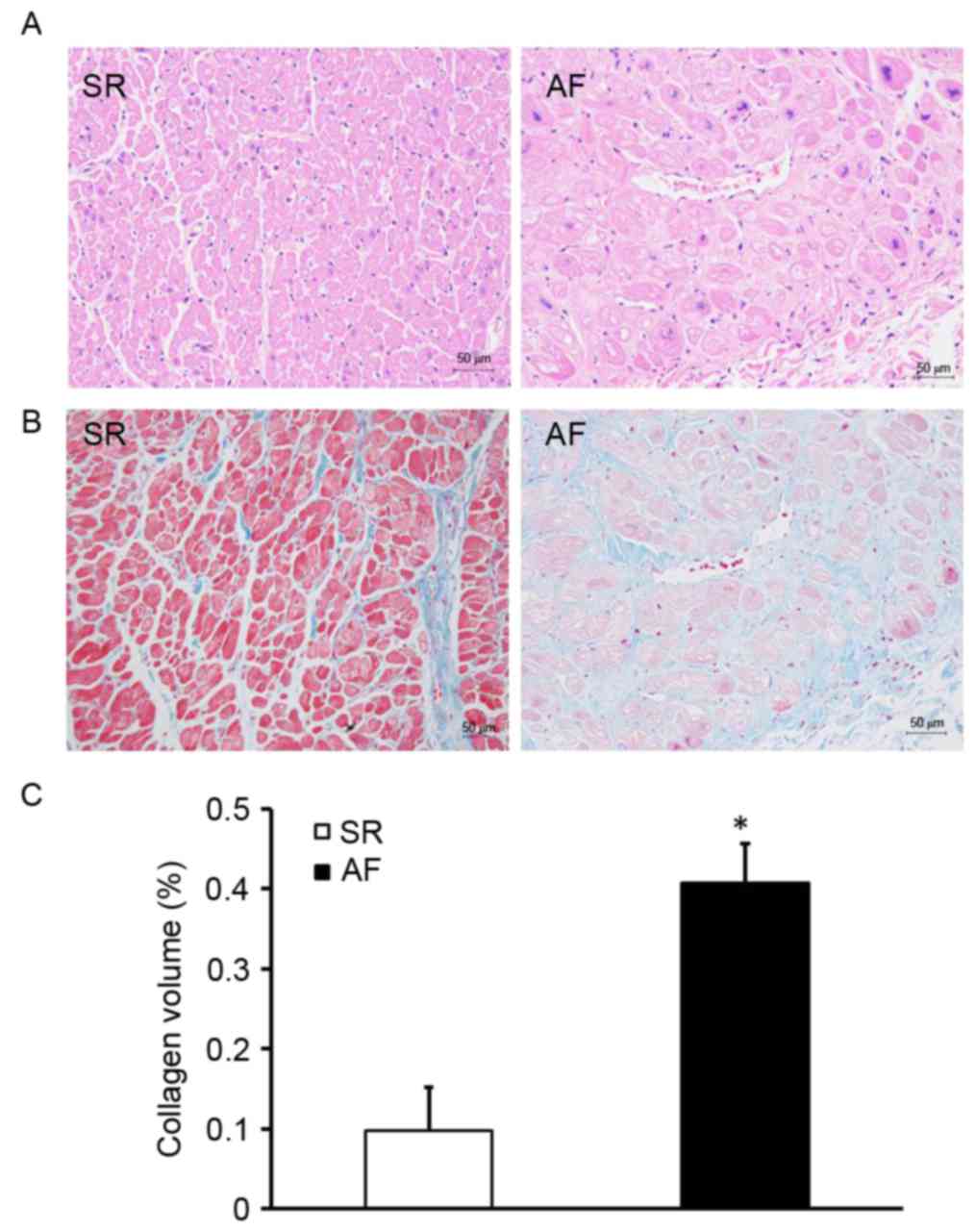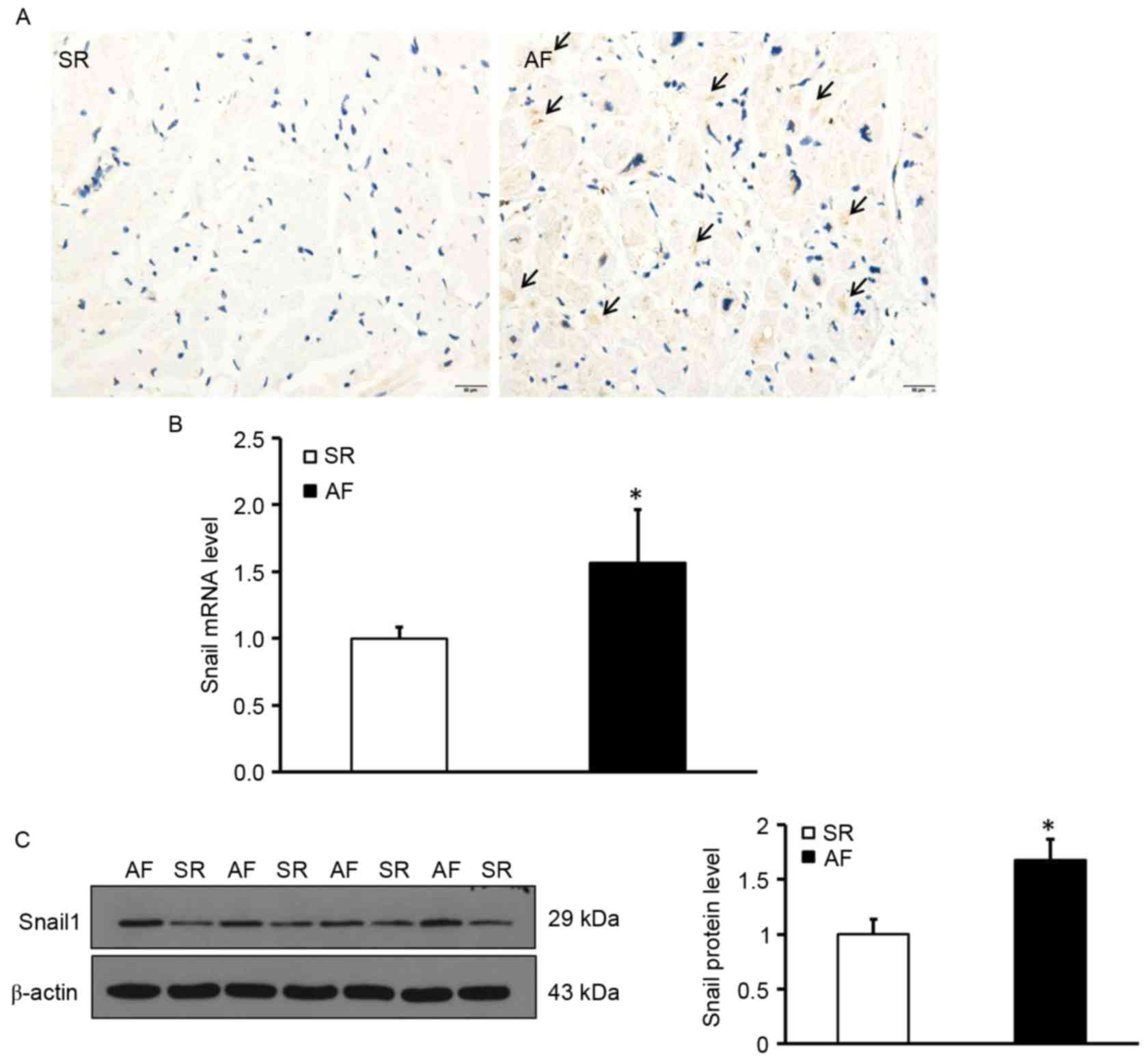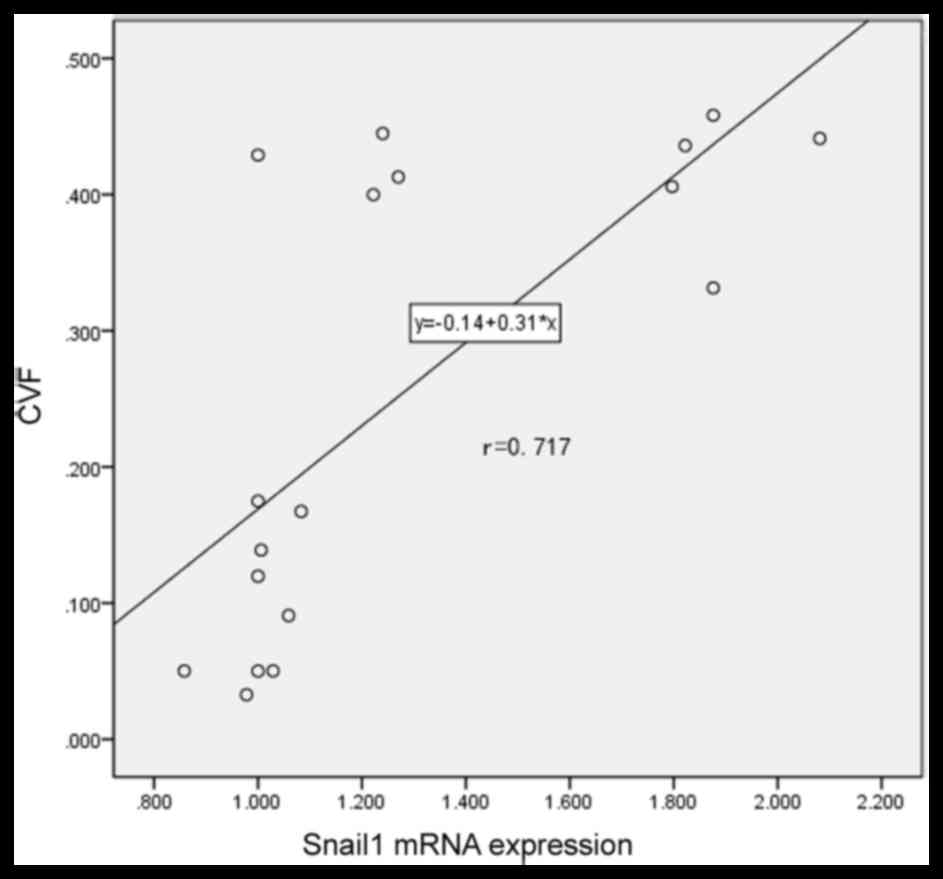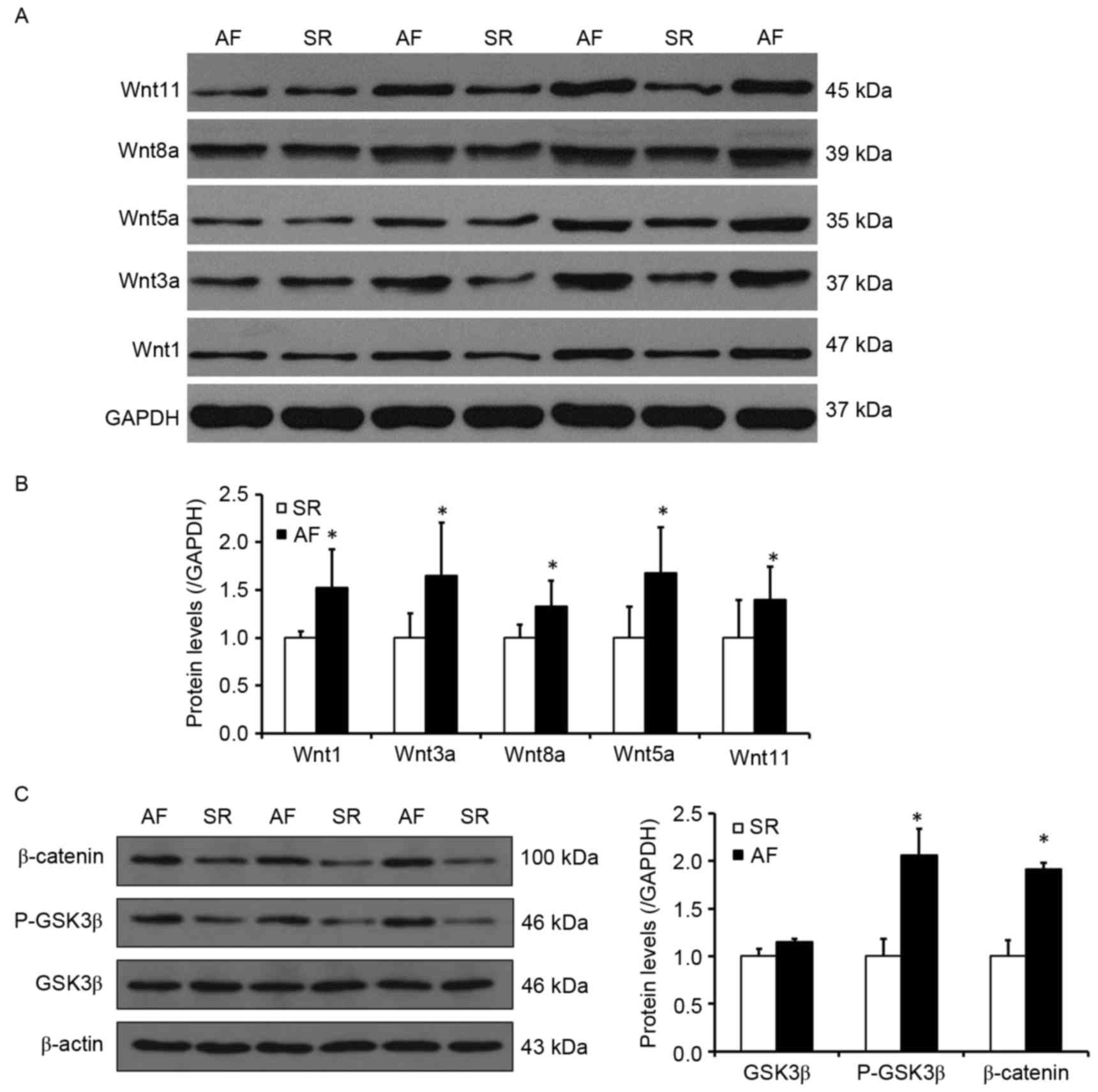|
1
|
Li M, Yi X, Ma L and Zhou Y: Hepatocyte
growth factor and basic fibroblast growth factor regulate atrial
fibrosis in patients with atrial fibrillation and rheumatic heart
disease via the mitogen-activated protein kinase signaling pathway.
Exp Ther Med. 6:1121–1126. 2013. View Article : Google Scholar : PubMed/NCBI
|
|
2
|
Jalife J and Kaur K: Atrial remodeling,
fibrosis, and atrial fibrillation. Trends Cardiovasc Med.
25:475–484. 2015. View Article : Google Scholar : PubMed/NCBI
|
|
3
|
Tan AY and Zimetbaum P: Atrial
fibrillation and atrial fibrosis. J Cardiovasc Pharmacol.
57:625–629. 2011. View Article : Google Scholar : PubMed/NCBI
|
|
4
|
Sun Y, Huang ZY, Wang ZH, Li CP, Meng XL,
Zhang YJ, Su F and Ma N: TGF-β1 and TIMP-4 regulate atrial fibrosis
in atrial fibrillation secondary to rheumatic heart disease. Mol
Cell Biochem. 406:131–138. 2015. View Article : Google Scholar : PubMed/NCBI
|
|
5
|
Zhang YJ, Ma N, Su F, Liu H and Mei J:
Increased TRPM6 expression in atrial fibrillation patients
contribute to atrial fibrosis. Exp Mol Pathol. 98:486–490. 2015.
View Article : Google Scholar : PubMed/NCBI
|
|
6
|
Miyasato SK, Loeffler J, Shohet R, Zhang
J, Lindsey M and Le Saux CJ: Caveolin-1 modulates TGF-β1 signaling
in cardiac remodeling. Matrix Biol. 30:318–329. 2011. View Article : Google Scholar : PubMed/NCBI
|
|
7
|
Zhang L, Huang B, Scherlag BJ, Ritchey JW,
Embi AA, Hu J, Hou Y and Po SS: Structural changes in the
progression of atrial fibrillation: Potential role of glycogen and
fibrosis as perpetuating factors. Int J Clin Exp Pathol.
8:1712–1718. 2015.PubMed/NCBI
|
|
8
|
Kiryu M, Niwano S, Niwano H, Kishihara J,
Aoyama Y, Fukaya H, Masaki Y and Izumi T: Angiotensin II-mediated
up-regulation of connective tissue growth factor promotes atrial
tissue fibrosis in the canine atrial fibrillation model. Europace.
14:1206–1214. 2012. View Article : Google Scholar : PubMed/NCBI
|
|
9
|
Wang R, Yi X, Li X and Jiang X: Fibroblast
growth factor-21 is positively associated with atrial fibrosis in
atrial fibrillation patients with rheumatic heart disease. Int J
Clin Exp Pathol. 8:14901–14908. 2015.PubMed/NCBI
|
|
10
|
Lamouille S, Xu J and Derynck R: Molecular
mechanisms of epithelial-mesenchymal transition. Nat Rev Mol Cell
Biol. 15:178–196. 2014. View
Article : Google Scholar : PubMed/NCBI
|
|
11
|
Baum B, Settleman J and Quinlan MP:
Transitions between epithelial and mesenchymal states in
development and disease. Semin Cell Dev Biol. 19:294–308. 2008.
View Article : Google Scholar : PubMed/NCBI
|
|
12
|
Hashimoto N, Phan SH, Imaizumi K, Matsuo
M, Nakashima H, Kawabe T, Shimokata K and Hasegawa Y:
Endothelial-mesenchymal transition in bleomycin-induced pulmonary
fibrosis. Am J Respir Cell Mol Biol. 43:161–172. 2010. View Article : Google Scholar : PubMed/NCBI
|
|
13
|
Tennakoon AH, Izawa T, Kuwamura M and
Yamate J: Pathogenesis of Type 2 Epithelial to Mesenchymal
Transition (EMT) in renal and hepatic fibrosis. J Clin Med.
5:pii:E42015. View Article : Google Scholar
|
|
14
|
Widyantoro B, Emoto N, Nakayama K,
Anggrahini DW, Adiarto S, Iwasa N, Yagi K, Miyagawa K, Rikitake Y,
Suzuki T, et al: Endothelial cell-derived endothelin-1 promotes
cardiac fibrosis in diabetic hearts through stimulation of
endothelial-to-mesenchymal transition. Circulation. 121:2407–2418.
2010. View Article : Google Scholar : PubMed/NCBI
|
|
15
|
Barrallo-Gimeno A and Nieto MA: The Snail
genes as inducers of cell movement and survival: Implications in
development and cancer. Development. 132:3151–3161. 2005.
View Article : Google Scholar : PubMed/NCBI
|
|
16
|
Liu Y, Du J, Zhang J, Weng M, Li X, Pu D,
Gao L, Deng S, Xia S and She Q: Snail1 is involved in de novo
cardiac fibrosis after myocardial infarction in mice. Acta Biochim
Biophys Sin (Shanghai). 44:902–910. 2012. View Article : Google Scholar : PubMed/NCBI
|
|
17
|
Dang Y, Liu B, Xu P, Zhu P, Zhai Y, Liu M
and Ye X: Gpr48 deficiency induces polycystic kidney lesions and
renal fibrosis in mice by activating Wnt signal pathway. PLoS One.
9:e898352014. View Article : Google Scholar : PubMed/NCBI
|
|
18
|
Kim TH, Kim SH, Seo JY, Chung H, Kwak HJ,
Lee SK, Yoon HJ, Shin DH, Park SS and Sohn JW: Blockade of the
Wnt/β-catenin pathway attenuates bleomycin-induced pulmonary
fibrosis. Tohoku J Exp Med. 223:45–54. 2011. View Article : Google Scholar : PubMed/NCBI
|
|
19
|
Ge WS, Wang YJ, Wu JX, Fan JG, Chen YW and
Zhu L: β-catenin is overexpressed in hepatic fibrosis and blockage
of Wnt/β-catenin signaling inhibits hepatic stellate cell
activation. Mol Med Rep. 9:2145–2151. 2014. View Article : Google Scholar : PubMed/NCBI
|
|
20
|
Livak KJ and Schmittgen TD: Analysis of
relative gene expression data using real-time quantitative PCR and
the 2(-Delta Delta C(T)) method. Methods. 25:402–408. 2001.
View Article : Google Scholar : PubMed/NCBI
|
|
21
|
Yu F, Lu Z, Huang K, Wang X, Xu Z, Chen B,
Dong P and Zheng J: MicroRNA-17-5p-activated Wnt/β-catenin pathway
contributes to the progression of liver fibrosis. Oncotarget.
7:81–93. 2016. View Article : Google Scholar : PubMed/NCBI
|
|
22
|
Boutet A, De Frutos CA, Maxwell PH, Mayol
MJ, Romero J and Nieto MA: Snail activation disrupts tissue
homeostasis and induces fibrosis in the adult kidney. EMBO J.
25:5603–5613. 2006. View Article : Google Scholar : PubMed/NCBI
|
|
23
|
Xu-Dubois YC, Galichon P, Brocheriou I,
Baugey E, Morichon R, Jouanneau C, Ouali N, Rondeau E and Hertig A:
Expression of the transcriptional regulator snail1 in kidney
transplants displaying epithelial-to-mesenchymal transition
features. Nephrol Dial Transplant. 29:2136–2144. 2014. View Article : Google Scholar : PubMed/NCBI
|
|
24
|
Rowe RG, Lin Y, Shimizu-Hirota R, Hanada
S, Neilson EG, Greenson JK and Weiss SJ: Hepatocyte-derived Snail1
propagates liver fibrosis progression. Mol Cell Biol. 31:2392–2403.
2011. View Article : Google Scholar : PubMed/NCBI
|
|
25
|
Zhou B, Honor LB, He H, Ma Q, Oh JH,
Butterfield C, Lin RZ, Melero-Martin JM, Dolmatova E, Duffy HS, et
al: Adult mouse epicardium modulates myocardial injury by secreting
paracrine factors. J Clin Invest. 121:1894–1904. 2011. View Article : Google Scholar : PubMed/NCBI
|
|
26
|
Duan J, Gherghe C, Liu D, Hamlett E,
Srikantha L, Rodgers L, Regan JN, Rojas M, Willis M, Leask A, et
al: Wnt1/βcatenin injury response activates the epicardium and
cardiac fibroblasts to promote cardiac repair. EMBO J. 31:429–442.
2012. View Article : Google Scholar : PubMed/NCBI
|
|
27
|
Ohnuki K, Umezono T, Abe M, Kobayashi T,
Kato M, Miyauchi M, Yamamoto N, Kimura M, Toyoda M and Suzuki D:
Expression of transcription factor Snai1 and tubulointerstitial
fibrosis in progressive nephropathy. J Nephrol. 25:233–239. 2012.
View Article : Google Scholar : PubMed/NCBI
|













